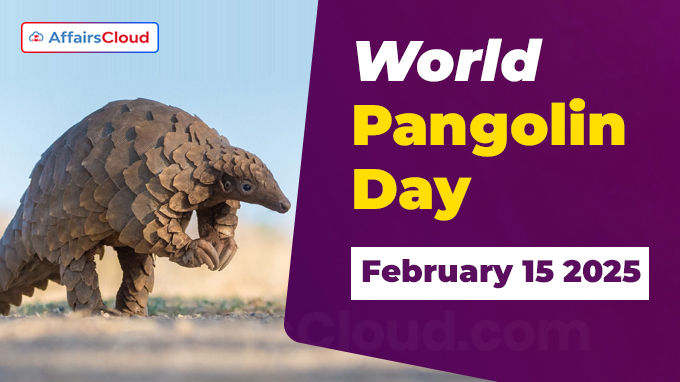 World Pangolin Day is observed annually on the third Saturday of February to celebrate pangolins or the scaly anteater, the most unique mammals on Earth and raise awareness about their conservation. The day aims to highlight the critical threats faced by these unique mammals, primarily due to illegal poaching and trafficking for their scales and meat.
World Pangolin Day is observed annually on the third Saturday of February to celebrate pangolins or the scaly anteater, the most unique mammals on Earth and raise awareness about their conservation. The day aims to highlight the critical threats faced by these unique mammals, primarily due to illegal poaching and trafficking for their scales and meat.
- In 2025, World Pangolin Day falls on 15th February 2024 marking the observance of the 14th World Pangolin Day.
- The 13th World Pangolin Day was observed on 17th February, 2024 and the 15th World Pangolin Day will be observed for February 21, 2026
Background:
i.The first-ever World Pangolin Day was celebrated in February 2012 and has since gained international recognition from animal welfare organizations and individuals around the globe.
ii.The day serves as a powerful reminder of the urgent need to protect pangolins and raise awareness about their endangered status.
About Pangolins:
i.Pangolins, also known as scaly anteaters, get their name from the Malay word “penggulung,” meaning “roller,” which refers to their unique self-defence behavior of curling up into a tight ball when threatened.
ii.These creatures are the only mammals fully covered in scales made of keratin, the same material found in human nails.
iii.With their distinct armor-like appearance and curled-up defence mechanism, pangolins stand out in the animal kingdom.
iv.As insectivores, they help control insect populations, particularly ants and termites, by consuming them in large quantities.
v.Pangolins lack teeth but have large curved claws for digging and a long, sticky tongue often longer than their body to retrieve insects.
Species of Pangolins:
i.There are 8 different species of pangolins, distributed across Asia and Africa.
ii.4 species in Asia: Chinese (Manis pentadactyla), Sunda (Manis javanica), Indian (Manis crassicaudata), and Philippine pangolins (Manis culionensis).
- The Sunda pangolin, also known as the Malayan or Javan pangolin, was found throughout South-East Asia (SEA).
iii.4 species in Africa: Temminck’s Ground (Smutsia temminckii), Giant Ground (Manis gigantea), White-bellied (Phataginus tricuspis), and Black-bellied pangolins (Phataginus tetradactyla).
- They live across the whole of sub-Saharan Africa (SSA) and was found as far south as Botswana and the Kalahari.
iv.Known locations: Brunei, Cambodia, Java, Sumatra, Borneo, the Lesser Sunda Islands, Laos, Malaysia, Singapore, Thailand, Myanmar and Vietnam. There are Indian and Chinese species, too.
Conservation Status of Pangolin Species:
i.All 8 species are listed as threatened with extinction on the International Union for Conservation of Nature (IUCN) Red List.
ii.The 2019 assessment by the Species Survival Commission (SSC) Pangolin Specialist Group categorized them as follows.
iii.Critically Endangered: Chinese (Manis pentadactyla), Sunda (Manis javanica), and Philippine (Manis culionensis) pangolins.
iv.Endangered: Indian (Manis crassicaudata), Giant (Manis gigantea), and White-bellied (Phataginus tricuspis) pangolins.
v.Vulnerable: Temminck’s Ground (Smutsia temminckii) and Black-bellied (Phataginus tetradactyla) pangolins.
Pangolin Trafficking and Conservation Efforts:
i.Pangolins are the most trafficked mammals globally, with an estimated one million individuals illegally harvested in the past decade.
ii.In China and Vietnam, pangolin scales are falsely believed to treat conditions like skin diseases and rheumatism, fueling the illegal trade of pangolins and their scales.
iii.Nigeria and other African nations hunted and consumed pangolins as bushmeat, contributes to their declining populations.
iv.In 2023, Nigeria took a stand against wildlife trafficking by publicly incinerating USD 1.4 million worth of seized pangolin scales.
v.From November to December 2024, a massive global operation against wildlife trafficking led to the seizure of nearly 20,000 live animals and the arrest of 365 suspects.
- Among the seized items were 12 live pangolins and over 4,472 kilograms (kg) of pangolin scales in Nigeria.
International Measures to Combat Trafficking:
i.CITES Appendix I: Pangolins are listed in Appendix I of the Convention on International Trade in Endangered Species of Wild Fauna and Flora (CITES) by the IUCN Red List.
ii.International Trade Ban (CoP17): In 2016, the 17th meeting of the Conference of the Parties (CoP17), held in Johannesburg, South Africa (SA) saw the introduction of a global commercial trade ban for all 8 species of pangolins.
iii.CoP19:In 2022, the 19th meeting of the Conference of the Parties (CoP19) held in Panama City (Panama), CITES urged countries to remove references to pangolin parts and derivatives from official pharmacopoeia.
Species in India:
i.India is a home of 2 species of pangolins- Chinese Pangolin (Manis pentadactyla) found in north-eastern India and Indian pangolin (Manis crassicaudata) were distributed in other parts of the country (Sri Lanka, Bangladesh, Pakistan).
ii.The 2 species are protected & are listed under the Schedule I Part I of the Wild Life (Protection) Act, 1972 and under Appendix I of the CITES.




